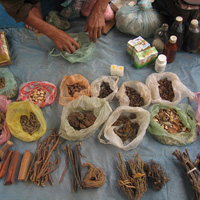
 The Indian science of Ayurveda has been practiced unbroken for thousands of years, handed down from teacher to student. Unfortunately during the time of British occupation of India, traditional arts including Ayurveda were actively discouraged. Since that time of foreign occupation India and its culture have slowly been recovering. But the truth is that Ayurveda still remains waiting for those earnest and perseverant students who bring Ayurveda back to its capacity. Fortunately, we have good texts in Ayurveda which have been preserved from ancient times. The Charaka Samhita is such a text which was written in poetic format.
The Indian science of Ayurveda has been practiced unbroken for thousands of years, handed down from teacher to student. Unfortunately during the time of British occupation of India, traditional arts including Ayurveda were actively discouraged. Since that time of foreign occupation India and its culture have slowly been recovering. But the truth is that Ayurveda still remains waiting for those earnest and perseverant students who bring Ayurveda back to its capacity. Fortunately, we have good texts in Ayurveda which have been preserved from ancient times. The Charaka Samhita is such a text which was written in poetic format.The Charaka Samhitha, believed to be the oldest Ayurvedic text on internal medicine, which is central to the modern-day practice of Ayurvedic medicine describes the medicinal qualities of 650 plants. These plants now form the raw materials for the herbal drug industry in India. The text was written by Charaka referring the books of Agnivesha and Athreya pupils. In the first medical conference in the world held at Himalaya in the leadership of Charaka in which 15 eminent scholars in Ayurveda participated and they discussed about the medicinal herbs, diagnosis, treatment and came to a conclusion of which result is Charaka Samhitha which includes 8 sections and 120 chapters. The eight sections which showcase every aspects of medical field are Suthra sthana(summary), which includes thirty chapters, Nidhanasthana(diagnosis) which includes 18 chapters, Vimanasthana(measurement), which includes eight chapters, Sharirasthana(on the body), which includes eight chapters, Indriyasthana(senses), which includes 12 chapters, Kisthana(treatment), which includes 30 chapters, Kalpasthana, which includes 12 chapters, siddhasthana(skill) which includes 12 chapters.
Charaka samhita also includes eight branches in Ayurveda; they are Kayachikistha(medicine), Salakya(deals with the diseases of super clavicular region), Salyapahartrka(deals with extraction of foreign bodies), Visa-gara vairodhika prasamana(deals with alleviation of poison), Bhuta vidya(spirits or organisms), Kaumarabhrtya(pediatrics), Rasayana(promotive measures). Charaka also describes three humours, Vata, Pitha and Kapha in his text.Vata include 80 disorders, Pita contain 40 disorders and Kapha comprise of 20 disorders. Charaka samhita gives solutions for these disorders, which distinguishes this book from other Ayurvedic books. Charaka samhitha describes time and seasonal treatments and specifies about the Rasayana Drugs(Neutra pseuticals) used for longevity of life, enhancing ability and skill.
Inappropriate relationship with environment and people resulted in life style disorders. Depression, stroke, obesity, arteriosclirosis, alzheimers, heart diseases, cancer, liver diseases, diabetes are the outcome of changing life style. Ayurvedic herbs with their therapeutic effect can protect these dangerous diseases.
Centella asiatica, Bacopa, Anise, Parsley, Celery can enhance memory power there by reducing the alzheimers. Abultion Indicom, Cassia fistula, Calotrophis giganta, Felipta postrate and Basilla Rubaca reduces Arteriosclerosis. Black pepper, sunflower, cardamom, seasame, and Terminalla arjuna can prevent heart diseases. Where as herbs llike Piperin, Popophyllin, Tinospora Cordifola, Semecarpus anacardium and Withania somnifeca cures all types of cancer. Aloe vera, Ashwagandha, Amalki, Tulsi, and Asparagus can be used as treatment for cancer. Lotus, Ginger, Pippali, Cummin helps to control Chronic Obstructive Pulmonary Disease. Raphanus Sativus, Rauwolfia serpentine, Beal fruit, Chiraita can control diabetes. Berry berry, Luffa cyllindrica, Bear Haavia diffussa, Anantmul, and Hapusha reduce Nephritis.
It will be a cynosure in the field of Ayurveda and elevates the niche of Ayurveda in country’s medical field. Knowing these plants in proximity would not only improve our knowledge on our great plant wealth, but also would make us proud of the rich heritage.
Article viewed at: Oye! Times at www.oyetimes.com
You can publish this article on your website as long as you provide a link back to this page.

Why ayurveda
The prognostic classification in Ayurveda, curative, reversible with some difficulty, irreversible but can be controlled with medication, irreversible even cannot be controlled could not be changed about a single disease till comment_date in spite of so much researches all over the world.
Some of the life saving & revolutionary molecules are driven from the herbs documented in Ayurveda.
Before three decade it was not possible to regenerate any types of damaged cells like hepatic, pancrease, nerve cells, but now gene therapy/stem cells implantation makes it possible. So at that time these aspects were conscomment_IDered as phylosophical but now its a science.
These concepts of repair, regeneration of damaged cells in some pathological state is described in Ayurveda & more advances than this; measures to rejuvenate the damaged cells due to ageing process & to prolong the age elaborately described.